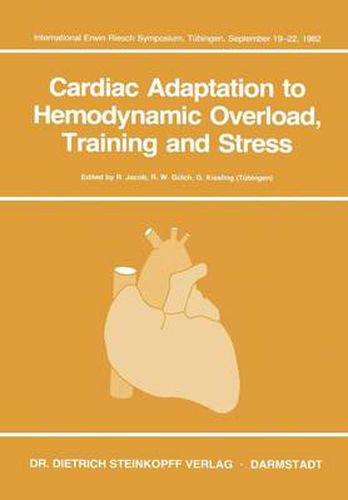Readings Newsletter
Become a Readings Member to make your shopping experience even easier.
Sign in or sign up for free!
You’re not far away from qualifying for FREE standard shipping within Australia
You’ve qualified for FREE standard shipping within Australia
The cart is loading…






This title is printed to order. This book may have been self-published. If so, we cannot guarantee the quality of the content. In the main most books will have gone through the editing process however some may not. We therefore suggest that you be aware of this before ordering this book. If in doubt check either the author or publisher’s details as we are unable to accept any returns unless they are faulty. Please contact us if you have any questions.
Cardiac hypertrophy and accompanying phenomena have received increasing attention in recent years - particularly in the basic sciences. The present volume contains the proceedings of the Erwin RIESCH SYMPOSIUM on CARDIAC ADAPTATION TO HEMODYNAMIC OVERLOAD, TRAINING AND STRESS held in Tiibingen on Sep tember 19-22, 1982. In addition to the topics of the previous symposia (1976 and 1979) concerned with problems of cardiac hypertrophy, the scope of this sequel meeting has been expanded to include related fields. The intention was to consider numerous related features and problems of chronic reactions of the heart (and vascular system) to abnormal hemodynamic loading, as well as alterations due to maturation, aging, training, neuroendocrine status and stress. Special attention has been paid to cardiac reactions at the level of contractile proteins. The results are considered primarily in light of long-term adaptation of the heart. Of course, research at the forefront of current knowledge need not always lead to congruent conclusions. Neither can the individual contributions always agree with the viewpoint of the editors. However, the broad array of individual approaches employed by biochemists, biolo gists, pathologists, physiologists, pharmacologists and clinical cardio logists will certainly help to provide a more balanced interpretation of the results in individual fields, stimulate reexamination of established con cepts and provide direction for future research.
$9.00 standard shipping within Australia
FREE standard shipping within Australia for orders over $100.00
Express & International shipping calculated at checkout
This title is printed to order. This book may have been self-published. If so, we cannot guarantee the quality of the content. In the main most books will have gone through the editing process however some may not. We therefore suggest that you be aware of this before ordering this book. If in doubt check either the author or publisher’s details as we are unable to accept any returns unless they are faulty. Please contact us if you have any questions.
Cardiac hypertrophy and accompanying phenomena have received increasing attention in recent years - particularly in the basic sciences. The present volume contains the proceedings of the Erwin RIESCH SYMPOSIUM on CARDIAC ADAPTATION TO HEMODYNAMIC OVERLOAD, TRAINING AND STRESS held in Tiibingen on Sep tember 19-22, 1982. In addition to the topics of the previous symposia (1976 and 1979) concerned with problems of cardiac hypertrophy, the scope of this sequel meeting has been expanded to include related fields. The intention was to consider numerous related features and problems of chronic reactions of the heart (and vascular system) to abnormal hemodynamic loading, as well as alterations due to maturation, aging, training, neuroendocrine status and stress. Special attention has been paid to cardiac reactions at the level of contractile proteins. The results are considered primarily in light of long-term adaptation of the heart. Of course, research at the forefront of current knowledge need not always lead to congruent conclusions. Neither can the individual contributions always agree with the viewpoint of the editors. However, the broad array of individual approaches employed by biochemists, biolo gists, pathologists, physiologists, pharmacologists and clinical cardio logists will certainly help to provide a more balanced interpretation of the results in individual fields, stimulate reexamination of established con cepts and provide direction for future research.